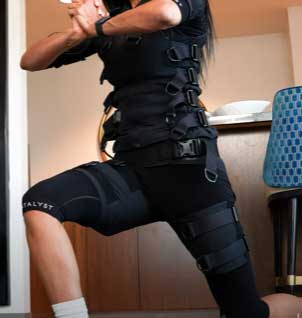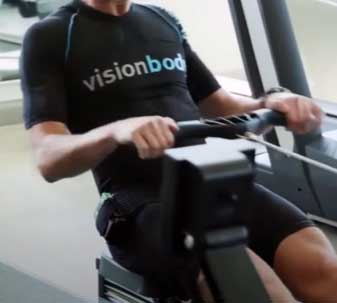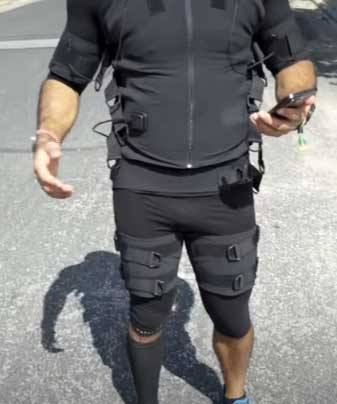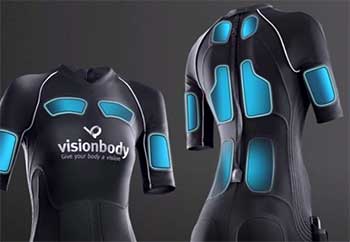Electrical muscle stimulation (EMS) has become an increasingly popular way to enhance workouts and improve fitness. Two leading EMS systems on the market today are Katalyst and Visionbody.
Both offer unique benefits and drawbacks compared to traditional exercise alone. This article will compare and contrast key features of Katalyst and Visionbody EMS to help determine which may be better suited for your needs and goals.
A Brief Comparison Table
| Feature | Katalyst | Visionbody |
| Specificity of Targeting | Precisely targets individual muscles | General full-body stimulation |
| Programs | Variety of presets for different goals | Standardized programs |
| Portability | Stationary gym unit | Highly portable personal system |
| Accessories | Includes masks, gloves, footwear | Just body suit |
| Cost | Around $5000+ | $1000-1500 range |
Overview of Katalyst And Visionbody EMS

EMS uses electrical impulses to contract muscles.
This allows users to activate more muscle fibers than volitional contraction during workouts.
Research indicates EMS can enhance strength, power, and endurance gains when combined with training.
It may also help build muscle, improve body composition, and support injury recovery.
Katalyst and Visionbody are full-body EMS suits worn during exercise. Electrodes in the fabric deliver impulses that stimulate muscles. This adds an extra challenge to workouts, engaging stabilizers and deep tissue muscles.
Sessions typically last 20-30 minutes. Most people do 2-3 per week alongside traditional training.
While Katalyst and Visionbody suits provide EMS benefits, their designs and features differ. Key variations include:
- Specificity of targeting: Katalyst uses proprietary mapping technology to target specific muscles. Visionbody has more general full-body stimulation.
- Programs: Katalyst offers workout programs focused on strength, endurance, recovery, and more. Visionbody has standardized programs.
- Portability: Visionbody systems are more portable while Katalyst units require a gym setting.
- Accessories: Katalyst features additional accessories like face masks and gloves. Visionbody keeps accessories minimal.
- Cost: Katalyst systems carry a higher price tag, around $5000, compared to Visionbody at around $1000-1500.
Understanding these key differences allows consumers to select the EMS system that best fits their training goals and budget.
Key Differences Between Katalyst And Visionbody EMS
- Targeted Stimulation
One major difference between Katalyst and Visionbody is the specificity of electrical stimulation provided.
Katalyst uses proprietary mapping technology to target specific muscles during workouts. Electrodes are strategically placed to activate individual muscle groups based on the exercise performed. For example, during a squat exercise the electrodes would trigger contractions in the glutes, quads, and calves.

This selective activation allows users to really focus on certain muscles during each move.
It helps ensure even hard-to-reach stabilizers and deep tissue get worked through the full range of motion.
The mapping and programming make stimulation more precise.
Contrastly, Visionbody delivers more general, full-body electrical stimulation.
The impulses reach all the major muscle groups simultaneously throughout a session. This provides an intense workout by engaging the entire body at once. But, it does not offer quite the same specificity and targeting as Katalyst.
So in summary, Katalyst provides a more customized experience by stimulating localized muscles for each exercise. Visionbody takes a broader approach, working all the muscles groups simultaneously.
- Workout Programs
Another key difference is the workout programs offered by each system.
The Katalyst software includes dozens of preset programs designed by experts. There are specific routines aimed at building strength, muscle endurance, cardiovascular fitness, or enhancing recovery.
The stimulation patterns, intensity levels, and recommended exercises differ based on the goal.
For example, the strength-building programs use higher stimulation to maximize muscle fiber recruitment during each move. Endurance-focused routines keep intensity lower but maintain it over multiple sets.
Users can pick programs based on their needs and the tech adjusts stimulation accordingly throughout the session.
Visionbody uses more of a one-size-fits-all approach with standardized programs. The main variations are total workout length and whether upper or lower body is emphasized. Intensity can be adjusted manually via the remote but does not autoregulate like Katalyst programs.
In practice, Katalyst’s targeted programs offer a more customized experience while Visionbody adopts generalized programming.
- Portability
There are also significant differences in the portability and use case for Katalyst vs Visionbody systems.

Katalyst is a relatively large, non-portable unit. It must remain stationary in a fitness studio or gym setting.
The stimulator, electrodes, wires, and software are housed in a central kiosk that clients access for their sessions.
This works very well for commercial gyms, rehab clinics, and training studios that offer Katalyst.
But it is not easily movable or viable for individual home use.
Conversely, Visionbody is designed as a highly portable, personal EMS system.
The stimulator is a small battery-powered device that can fit in a bag. Electrodes are built into a flexible, lightweight suit.
This allows users to do sessions virtually anywhere – at home, while traveling, outdoors, or in a hotel room. Everything is self-contained and mobile.
So Katalyst caters to facility use while Visionbody offers better commercial viability through its portability. Those looking to use EMS privately would benefit more from the transportable Visionbody.
- Accessories
Katalyst also integrates more accessories into its EMS system compared to the minimalist Visionbody.
The Katalyst units generally come with various face masks, gloves, and footwear electrodes. These enhance stimulation to targeted facial and extremity muscles for a complete head-to-toe experience.
Visionbody’s streamlined, pared-down approach focuses just on the body suit. There are no additional accessories to worry about or set up. This improves simplicity and portability. However, it does limit stimulation to just the core and large muscle groups.
Including proprietary accessories allows Katalyst to offer more precise, comprehensive stimulation. But some may prefer Visionbody’s simplicity and convenience instead.
- Cost
Lastly, the price tag differs noticeably between the two EMS systems. This can certainly be a key factor when selecting the right option.
Complete Katalyst packages usually retail around $5000+ for the full gym unit, software, accessories, training, and support. Leasing options can reduce upfront costs but still require a serious investment, especially for commercial gyms. It is a premium product priced accordingly.
Visionbody costs significantly less, typically ranging from $1000-1500 for a personal suit and stimulator package. This puts it in reach for more individual users compared to the higher business costs of Katalyst installations. Additional suits and accessories add just a few hundred dollars.
In the end, Katalyst offers more bells and whistles at a premium price point, while Visionbody provides budget-friendlier access to basic EMS benefits. Carefully weigh costs against your specific needs.
Making The Right Choice
When comparing Katalyst and Visionbody EMS systems, it’s important to consider your unique fitness objectives and budget.
Katalyst offers an unparalleled degree of personalized, precision stimulation but at a premium cost. The numerous programs and accessories provide a comprehensive experience for serious training buffs and athletes.
It works best as a commercial studio investment rather than individual home system.

For most casual users, Visionbody provides a more accessible budget-friendly option.
The full-body stimulation adds extra intensity during workouts for less.
Plus the portability enables use anywhere, not just a facility.
Those seeking solid EMS benefits without advanced customization will appreciate Visionbody’s simplicity and affordability.
Focus on your specific goals, needs, and financial situation when deciding between the two. Katalyst and Visionbody use EMS technology in slightly different ways to enhance workouts and take your training to the next level. Evaluate the key differences and features that are most valuable for your circumstances.
Frequently Asked Questions (FAQ)
Yes, research has shown that Katalyst provides proven benefits when combined with exercise. The EMS technology helps users improve strength and endurance, build bigger muscles, burn more calories, and recover faster compared to training alone. The precision targeting elicits greater muscle activation than volitional effort. Most users notice a real difference in their workouts and progress.
Katalyst is one of the premier and most advanced EMS systems available. The strategic muscle targeting, customized programming, and accessories make it an unparalleled training tool for serious athletes and fitness buffs. It goes far beyond basic EMS technology to provide a truly customized experience. If you have the budget and access to Katalyst, it’s an extremely effective way to enhance performance, body composition, and recovery.
The Katalyst system is sold as a complete package including the stimulator, software, accessories and training – not just the suit alone. Full commercial gym packages generally start around $5000. Additional suits and replacement electrodes add a few hundred dollars more per person. Leasing options for studios can reduce upfront costs. It is a major investment designed foremost for commercial facilities rather than individual purchase.
Katalyst is an advanced electrical muscle stimulation (EMS) system that enhances workouts. The technology uses pre-programmed electrical impulses to contract muscles, allowing you to activate more fibers and reach exhaustion with less volitional effort. This makes each rep more effective and efficient. Katalyst goes beyond basic EMS with its strategic muscle targeting and customized programming tailored to your goals. It complements training to boost strength, endurance, muscle growth, and other markers of fitness to new levels.
So in summary, Katalyst fitness utilizes innovative EMS technology to make workouts more productive and deliver better training results compared to exercise alone. It helps fitness enthusiasts, athletes, and clients take their training, body composition, and performance to new heights.
Wrapping UP
Katalyst and Visionbody both offer effective electrical muscle stimulation systems to enhance workouts. But they differ in their specificity of targeting, built-in programs, portability, accessories, and costs.
Katalyst provides a completely customized experience through advanced muscle mapping and varied training programs. But it requires a serious investment best suited for commercial facilities. Visionbody offers more accessibility for casual users through its affordability and transportability.
Evaluate your own goals, needs, and budget to determine if the premium precision of Katalyst or convenience of Visionbody better fits your EMS needs. Taking advantage of this technology can help you power past plateaus to reach new levels of strength, muscle, endurance and overall exercise benefits.
